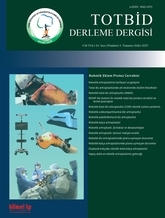
Robotic-assisted knee arthroplasty surgeries have made significant progress in orthopedic surgery in recent years. This method, which offers more precise and personalized prosthesis placement compared to traditional knee arthroplasty techniques, determines the most appropriate prosthesis size and position by analyzing the patient`s knee anatomical structure in detail with or without imaging before the operation. In addition, it acts under the guidance of the surgeon in bone incisions made with the help of a robotic arm or hand held systems and ensures that the prosthesis is placed correctly without damaging the soft tissues. At the same time the software of some robotic systems can give more information about the ligament balance of the prosthetic components and that provide a great advantage compared to the traditional system in terms of postoperative range of motion gain. In this section, the surgical steps of the total knee arthropalsty application of the CORI robotic system, which can extract the three-dimensional model of the bone during surgery without using any radiological imaging method and using hand-held circular burr based bone cutter, are summarized.